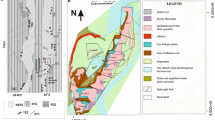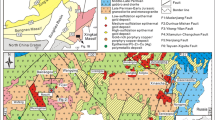Abstract
Mineral parageneses of the polymetallic, Sbrich deposit at Dúbrava has been formed during five separated stages. A fluid inclusion study demonstrates that the earliest stages with scheelite, molybdenite and arsenopyrite have been associated with immiscible CO2 (± CH4)-rich, low-saline fluids at temperatures between 300 and 400 °C and pressures as much as 2 kbar. Deposition of the main, superimposed ores, stibnite and zinckenite, has been intimately connected with circulation of aqeuous, moderately saline fluids (15.5–23.5 wt% NaCl equiv.) upon epithermal conditions. Salinity of the aqueous fluids associated with tetrahedrite is clustered around 10 wt% NaCl equiv. Quartz from the latest, barite stage has precipitated from aqueous fluids enriched in divalent cations. These fluids are believed to be genetically linked with Triassic evaporite formations preserved in the region. Temperature-salinity diagrams constructed from microthermometry data indicate influx of diluted meteorite water in the stibnite, tetrahedrite and barite stages. Isotopic data are in accordance with model. The δ 18O values between −9.3‰ and +1.5‰ have been derived for water in equilibrium with quartz, coexisting with sphalerite, tetrahedrite and barite, thus confirming the participation of isotopically lighter meteoric waters in the mineral-forming solutions. The (δ 18O) values between +3.3‰ and +8.5‰ estimated for the water associated with the scheelite and arsenopyrite stages, are suggestive for the majority of metamorphic and/or magmatic water in the mineral-forming, CO2-rich solutions.
Similar content being viewed by others
References
Biely, A. (1992) Geological map of the Nízke Tatry Mountains, 1∶50000. SGÚ-GÚDŠ, Bratislava
Bodnar, R.J. (1992) Revised equation and table for freezing-point depressions of H2O-salt fluid inclusions. PACROFI IV Symposium — Program and Abstracts, Lake Arrowhead, California, USA, May 21–25, 1992, p. 15
Boiron, M.C., Cathelineau, M., Trescases, J.J. (1989) Conditions of gold-bearing arsenopyrite crystallisation in the Villeranges Basin, Marche-Combrailles shear zone, France: a mineralogical and fluid inclusion study. Econ. Geol. 84:1340–1362
Borisenko, A.S. (1977) The study of salt composition of fluid inclusions in minerals using the cryometric technique (In Russian). Geol. i. Geofiz. 8:16–27
Bottinga, Y., Javoy, M. (1973) Comments on oxygen isotope geothermometry. Earth Planet. Sci. Lett. 20:250–265
Bozzo, A.T., Chen, J.R., Barduhn A.J. (1973) The properties of the hydrates of chlorine and carbon dioxide. In: Delyannis, A., Delyannis, E. (eds.) 4th International Symposium on Fresh Water from Sea, vol. 3. Heidelberg, pp. 437–451
Bril, H. (1989) Deposition conditions for some antimony (As) vein mineralisation in the Hercynian basement: data from fluid inclusions, W. Europe. ECROFI X Symposium — Abstracts, London, UK, April 1989, p. 17
Bril, H., Beaufort, D. (1989) Hydrothermal alteration and fluid circulation related to W, Au, and Sb vein mineralisations, Haut Allier, Massif Central, France. Econ. Geol. 84:2237–2251
Bril, H., Nenert, S. (1987) Le district auro-antimonifere de Benevent L'Abbaye (Limousin, Massif central français): paragenèses et inclusions fluides. Resultats préliminaires. ECROFI IX Symposium — Abstracts, University of Oporto, Portugal, May 4–6, 1987, p. 135
Burruss, R.C. (1981) Analysis of fluid inclusions: phase equilibria at constant volume. Am. J. Sci. 281:1104–1126
Cambel, B., Kráł, J., Burchart, J. (1990) Isotopic geochronology of the Western Carpathian crystalline complexes (In Slovak). Veda, Bratislava, 183 pp
Chovan, M. (1990) Mineralogical-paragenetic relations on the Dúbrava Sb deposit and their significance for the metallogeny of the Nízke Tatry Mts. Acta Geol. Geogr. Univ. Comenianae 45:89–101
Chovan, M., Michálek, J. (1988) Bismuthite and tetradymite in the Dúbrava Sb-deposit, Middle Slovakia. (In Slovak). Miner. Slovaca 20:161–168
Dunning, F.W., Evans, A.M. (1986) Mineral deposits of Europe, vol. 3: Central Europe. Inst. Miner. Metall. Miner. Soc., London, pp. 1–355
Hak, J. (1966) Mineralogy and geochemistry of antimony deposits in the Nízke Tatry Mts. (In Czech). Sbor. Geol. Věd, TG-7:71–144
Harman, M. (1956) Geological and paragenetic relations in the north-western part of the Dúbrava deposit and some remarks to the ores in the Nizke Tatry Mts. (In Slovak). Geol. Práce-Zošity 6:56–66
Hurai, V. (1992) Immiscibility in the system H2O-CO2-NaCl: Applications to fluid inclusion thermobarometry. Neues Jahrbuch Miner. Abh. 165, 1:5–17
Hojstričová, M., Chovan, M. (1990) Alterations of the host rocks. In: Chovan, M. (ed.) Mineralogy, geochemistry, petrology of the impregnation- and vein-type mineralisation in the region Dúbrava-Łubelská (In Slovak). Unpublished report, Comenius University, Bratislava, pp. 286–330
Ilavský, J. ed. (1979) Metallogenése de l'Europe alpine centrale et du sud-est. GÚDŠ, Bratislava, pp. 1–413
Jakeš, P. (1963) Contribution to the knowledge on antimony-bearing veins at the northwestern slopes of the Nízke Tatry Mts. in the region of the Dúbrava locality. (In Czech). Acta Univ. Carol. Geol. 3:159–178
Maheł, M. (1986) Geological structure of the Czechoslovak Carpathians. (In Slovak). Veda, Bratislava, pp. 1–503
Michálek, J. (1983) Dúbrava-Lubelská Sb (In Slovak). Unpublished report, Geological Survey Sp. Nová Ves, pp. 1–143
Munoz, M., Shepherd, T.J. (1987) Fluid inclusion study of the Bournac polymetallic (Sb-As-Pb-Zn-Fe-Cu...) vein deposit (Montagne Noire, France). Mineral. Deposita 22:11–17
Nicholls, J., Crawford, M.L. (1985) FORTRAN programs for caluculation of fluid properties from microthermometric data on fluid inclusions. Comput. Geosci. 11:619–645
Oakes, C.S., Bodnar, R.J., Simonson, J.M. (1990) The system NaCl-CaCl2-H2O: I. The ice liquidus at 1 atm total pressure. Geochim. Cosmochim. Acta 54:603–610
Ortega, L., Vindel, E., Dubessy, J. (1991) Fluid evolution in a boiling system around a cooling granite: a Hercynian antimony deposit case study. In: Benvenuti, M. (ed.) ECROFI XI Symposium — Abstracts, Firenze, Italy April 10–12, 1992. Plinius 5:162–163
Pichavant, M., Ramboz, C., Weisbrod, A. (1982) Fluid immiscibility in natural processes: use and misuse of fluid inclusion data. Chem. Geol 37:1–27
Roedder, E., Bodnar, R.J. (1980) Geologic pressure determination from fluid inclusion studies. Earth. Planet. Sci. Ann. Rev. 8:263–301
Sachan, H.K. (1990) Physico-chemical conditions for the formation of Dúbrava antimony deposit (Western Carpathians). PhD Thesis, Comenius University, Faculty of Natural Sciences, Bratislava, pp. 1–123
Sachan, H.K., Chovan, M. (1991) Thermometry on arsenopyrite-pyrite mineralisation in the Dúbrava antimony deposit (Western Carpathians). Geol. Carpath. 42, 5:265–269
Sachan, H.K., Kantor, J. (1990) Sulphur isotopic study of the Dúbrava antimony deposit, Nízke Tatry Mts., Czechoslovakia. Geol. Zborník Geol. Carpath. 41, 6:749–757
Siegl, K. (1976) The structure of the Low Tatra pluton (West Carpathians). Geol. Zborn. Geol. Carpath. 27:149–164
Spišiak, J., Arvensis, M., Linkešová, M., Pitoňák, P., Caňo, F. (1991) Basanite dike in granitoids near Dúbrava (Low Fatra Mtr., Central Slovakia) (In Slovak). Miner. Slovaca 23:339–345
Spišiak, J., Pitoňák, P. (1990) Petrography of the country rocks. In: Chovan, M. (ed.) Mineralogy, geochimistry, petrology of the impregnation- and vein-type mineralisation in the region Dúbrava-Łubelská (In Slovak). Unpublished report, Comenius University, Bratislava, pp. 146–285
Taylor, H.P., Jr (1979) Oxygen and hydrogen isotope relationships in hydrothermal mineral deposits. In: Barnes, H.L. (ed.) Geochemistry of hydrothermal ore deposits. Wiley, New York Chichester Brisbane Toronto, pp. 236–277
Author information
Authors and Affiliations
Rights and permissions
About this article
Cite this article
Chovan, M., Hurai, V., Sachan, H.K. et al. Origin of the fluids associated with granodiorite-hosted, Sb-As-Au-W mineralisation at Dúbrava (Nízke Tatry Mts, Western Carpathians). Mineral. Deposita 30, 48–54 (1995). https://doi.org/10.1007/BF00208876
Received:
Accepted:
Issue Date:
DOI: https://doi.org/10.1007/BF00208876




